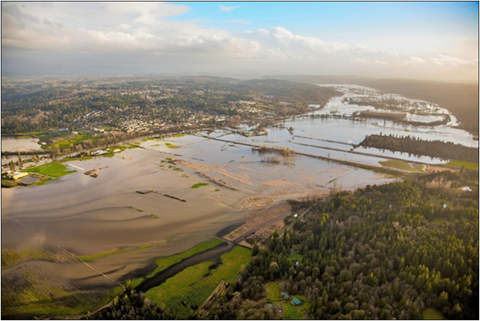2024 King County Flood Management Plan
2024 King County Flood Management Plan
Flooding happens in King County. Flood risks are managed through the King County Flood Management Plan. Lets plan for the future together. Learn more about flooding in King County and the resources available to reduce flood risks on our Flood Services web site. Interpretation and translation services are available to you at no cost. If you need them, please contact us at 206-263-2677.
The Flood Management Plan guides how King County manages flood risks along our rivers, creeks, and shorelines. On June 6, King County Executive Dow Constantine proposed the 2024 King County Flood Management Plan to the Metropolitan King County Council. The Council’s Local Services and Land Use Committee will review the plan and associated legislation and issue a recommendation for full Council action. Please check the Local Services and Land Use Committee webpage for updates about the Council’s review.
The public comment periods for the Draft Flood Plan and associated Environmental Impact Statement are closed. Here is a summary of the public comments received.
Presentations and recordings from recent public meetings
During the public comment period, King County hosted two online public meetings.
View the presentation and video from the Feb. 15, 2024 online public meeting
View the presentation and video from the Mar. 7, 2024 online public meeting
Let's plan for flood resilience together
Flooding is our region’s most common natural disaster and is a part of life in King County. Flooding can be devastating to neighborhoods. Floods damage homes, destroy personal property and put lives at risk. Floods also affect access to jobs, stores and schools and can damage community open spaces. Flooding is likely to get more frequent and severe with climate change.
Natural disasters affect people differently, with some having a harder time recovering, or perhaps not recovering at all. Building flood resilience means that we are increasing the ability for people and communities to recover quickly from whatever impacts flooding brings to our doorsteps. Flooding will never disappear in King County, but being prepared can reduce the risks for communities, families, and individuals.
The flood plan guides how we manage flood risks and how the benefits of our efforts are distributed across the county. Information on this site is organized into five sections:
- Flooding and building flood resilience - background information and resources
- Planning for flood resilience - introduction to the plan, the process for updating the plan, and why the plan matters
- What we've heard from you - a report on the feedback we've recieved so far
Sign up to receive email updates about the flood plan!
Snoqualmie River flooding near Duvall in December 2015.
Contacts
For general information or assistance with questions about flooding, please contact:
King County River and Floodplain Management Section
206-477-4812
For questions about the flood plan update, please contact:
Jason Wilkinson
Project Manager
206-477-4786
Jason.Wilkinson@kingcounty.gov

 October 2021 - September 2022
October 2021 - September 2022 October 2022 - June 2023
October 2022 - June 2023 July 2023 - October 2023
July 2023 - October 2023 Ongoing
Ongoing October 2022 - December 2023
October 2022 - December 2023 January 2024 - March 2024
January 2024 - March 2024 May 2024 - June 2024
May 2024 - June 2024 June 2024 - September 2024
June 2024 - September 2024